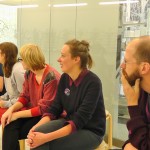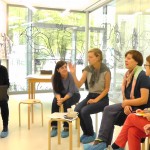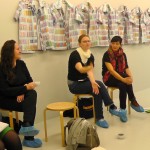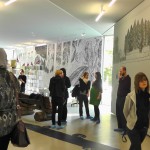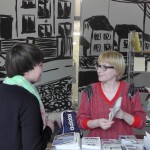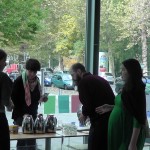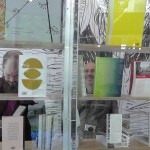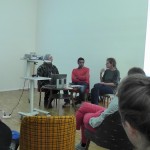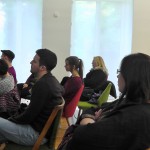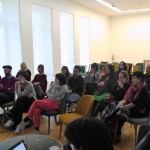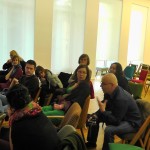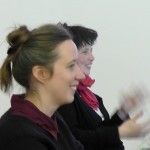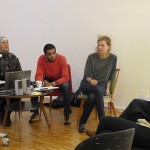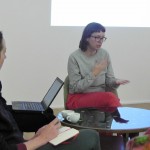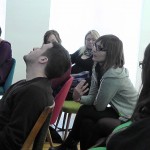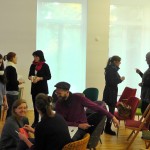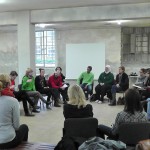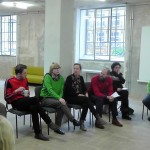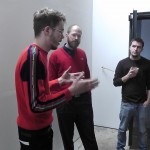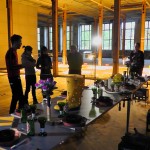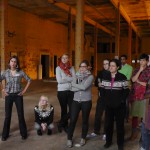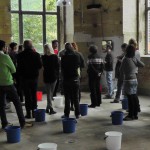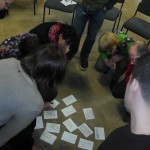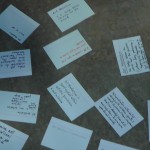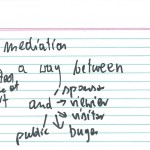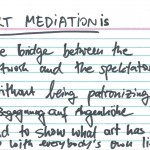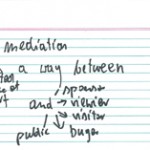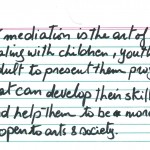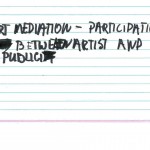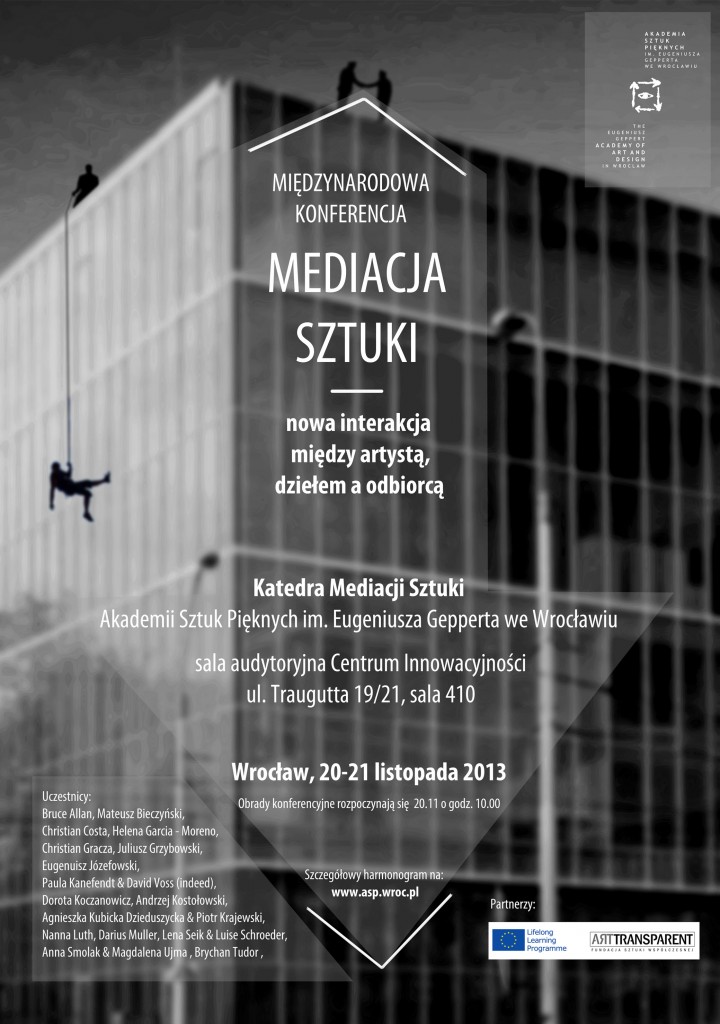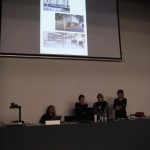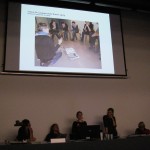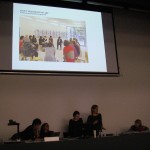ABOUT MEDIATION OF ART
In October 2013 the 1. International Symposium “About Mediation of Art” took place within the MitOst-Festival in Leipzig. Hosts of the symposium were GfZK (Museum of Contemporary Art) and HALLE 14. Actors in the field of art and culture from Egypt, Poland, Czech Republic, Spain and Germany came together to discuss several basic aspects of art mediation. Main questions were asked regarding to the definition of the term “art mediation”, its structure and appearance and the importance of co-laborations between professionals. (→ for detailed information see above in the final report PDF)
In the field of the arts and especially in contemporary art, one notices the growing need for supporting the general public in relation to the appreciation and understanding of artworks. Beyond the frame of the exhibition of artworks within art spaces and museums the process of art mediation links artistic ideas and concepts to peoples engagement. With the help of artistic techniques and methods it gives the option to empower pupils, citizens, patients to start designing life and community from their perspective under their special conditions – and being creators and translators from ideas to reality.
How could people be engage with works of art? This subject would be discussed in four panels each focused on a differnt question about mediation of art.
ABOUT MEDIATION OF ART (Über die Vermittlung von Kunst)
Im Oktober 2013 fand das 1. Internationale Symposium “About Mediation of Art” (Über die Vermittlung von Kunst) im Rahmen des MitOst-Festivals in Leipzig statt. Gastgeber der Veranstaltung waren die Galerie für Zeitgenössische Kunst (GfZK) und die HALLE 14.
Akteure aus Kunst und Kultur aus Ägypten, Polen, Tschechischer Republik, Spanien und Deutschland kamen zusammen um verschiedene elementare Aspekte von Kunstvermittlung zu diskutieren. Die wichtigsten Fragen richteten sich an die Definition des Begriffs “Art Mediation/Kunstvermittlung”, die Struktur und ihrem Erscheinen sowie des Stellenwertes von Kooperationen zwischen den Kunst-und Kulturschaffenden und Institutionen der Bildung, Wissenschaft und Gesellschaft.
Im Feld der Kunst und insbesondere der zeitgenössischen Kunst ist zu beobachten, dass das Bedürfnis nach Unterstützung beim Zugang zu den Kunstwerken groß ist. In Kunstausstellungen, Kunsträumen und Museen verbindet der Prozess der Kunstvermittlung künstlerische Ideen und Konzepte mit den Erfahrungen der Besucher. In der Auseinandersetzung mit künstlerischen Methoden und Techniken können Menschen jeden Alters die Befähigung finden, ihr Leben, ihr Lebensumfeld und ihre Gesellschaft aktiv mitzugestalten. Aus ihrer eigenen Perspektive und mit ihren eigenen individuellen Fähigkeiten können sie so ihre Ideen selbst Wirklichkeit werden lassen.
In insgesamt vier Panels wurde mit jeweils unterschiedlichem Fokus der Frage nachgegangen, wie Menschen in Begegnung und in Dialog mit Kunstwerken kommen können.
1. HOW TO STRUCTURE ART MEDIATION? PART 1
The panel asked about different kinds of strategies that art mediation can implement: curatorial concepts, exhibitional displays and visitors participation.
Another form of mediation is the field of cultural learning and education. Participants were invited to introduce their experiences and art projects.
Within the setting and the display of the town Zastávka at the current exhibition “at sixes and sevens” at the Museum of Contemporary Art curator Julia Schäfer introduces the aspect of art mediation of the exhibition, which is developed by the artist Kateřina Šedá and a group of young people together. Regarding to art mediation in general Julia likes to connect curating and mediation; she prefers to invite people to the process of the preparation of the exhibition.
A talk between Julia, the art mediation team of GfZK and the participants followed. (→ see also the discussion recorded in the final report PDF above)
1. WIE KANN KUNSTVERMITTLUNG UMGESETZT WERDEN? PART 1
Es wurde erkundet, was Kunstvermittlung bedeuten kann und welche unterschiedlichen Strategien im Feld der Kunstvermittlung zu finden sind.
In diesem Sinne wurden die konzeptuelle Arbeit von Kuratoren, die als Displays zu begreifenden Ausstellungen und die Mitwirkung von Besuchern als Formen der Kunstvermittlung beleuchtet. Hinzu kam der Bereich der kulturellen Bildung. Die Referenten und Teilnehmer waren eingeladen, ihre Projekte vorzustellen und Erfahrungen auszutauschen.
Innerhalb der Umgebung des Ortes Zastávka bzw. des Displays der aktuellen Ausstellung „at sixes and sevens (von links nach schräg)“ im Neubau der Galerie für Zeitgenössische Kunst startete das erste Panel. Kuratorin Julia Schäfer sprach über die Aspekte von Kunstvermittlung innerhalb des Ausstellungskonzepts, welches von der Künstlerin Kateřina Šedá und Jugendlichen aus Zastávka gemeinsam entwickelt wurde. In ihrer eigenen Arbeit verfolgt Julia Schäfer eine Art experimentelles Kuratieren, indem sie verschiedene Konzepte entwickelt, bei denen sie den Kunstraum auch für andere Akteure öffnet. (→ mehr dazu im Protokoll siehe oben)
Impulse by Julia Schäfer, Curator, and Lena Seik, Manager Art Mediation Program, Galerie für Zeitgenössische Kunst, Leipzig/Germany
Panel 1:
09.10.2013
11:00 – 12.30 Uhr
Galerie für Zeitgenössische Kunst Leipzig
Neubau/New Building – within the current exhibition AT SIXES AND SEVENS by Kateřina Šedá
2. HOW TO DEAL WITH OPTIONS, OBSTACLES AND FRAME CONDITIONS?
In 2013 the 1. Di-Egy Fest, festival for digital art took place in Cairo. Elham Khattab and Mostafa Saad Abdelsamia talked about their experiences of the 1st Di-Egy Festival in Cairo. From the beginning for the festival team it was very clear to implement an art mediation section within the program mostly oriented to children and young people from a difficult social background. During their presentation Elham and Mostafa explained the importance to enable those target groups an approach to digital art as well as the positive and critical aspects of digital life and its options. To offer art workshops for kids is quite usual in Egypt but to implement them within an exhibitional frame and to call it “Art Mediation” was new.
This leaded the symposium to the next discussion about the questions:
What is the definition of “Art Mediation”? Does the literal term refer to the action?
What distinguishes Art Mediation from Art Education?
(→ see above in the final report PDF)
Impulse by Elham Khattab and Mostafa Saad Abdelsamia, Di-Egy Festival, Cairo/Egypt; Lena Seik, Galerie für Zeitgenössische Kunst, Leipzig/Germany
Panel 2:
09.10.2013
14:00 – 15.30 Uhr
Galerie für Zeitgenössische Kunst Leipzig
Altbau/Villa – Auditorium
3. HOW TO STRUCTURE ART MEDIATION? PART 2
The third panel asked again about different kinds of strategies like curatorial concepts, exhibitional displays and visitors participation – this time at HALLE 14, center of contemporary art at SPINNEREI (former spinning factory now an area of art and culture).
After visiting the current exhibition “The Politics and Pleasures of Food” the assistent curator Lukas Holldorf talked about backgrounds and conditions in team work withh chef curator Frank Motz. Afterwards the art mediation team talked about their situation, about programs, frame conditions and obstacles. (→ see above for further details in the final report PDF)
Impulse by Lukas Holldorf, Curator, Paula-Marie Kanefendt and Ina Nitzsche, Managers Art Mediation Program HALLE 14
Panel 3:
10.10.2013
10.30 – 12.00 Uhr
HALLE 14
4. DISCUSSION: HOW TO COLLABORATE? HOW TO CREATE A PLATFORM?
Projects in the field of art mediation are mostly cooperative projects with partners from the art
section and other institutions, such as public schools or associations of arts and culture or
others like nature or sience.
Actually we wantet to ask What makes a collaboration running? How to stabilise such a network?
And how to keep it alive?
But instead we were working towards the definition of Art Mediation again and ask the following questions:
What is art mediation?
Who needs art mediation?
Is it easier for children to deal with contemporary art?
What is important for a „successfull“ art mediation?
Does art mediation need a special place?
Does some art „need“ more mediation effort than others?
Moderation: Lena Seik, Paula-Marie Kanefendt, David Voss
Panel 4:
10.10.2013
13:00 – 14.30 Uhr
HALLE 14
The Symposium took place within the frame of MitOst-Festival 2013.
Das Symposium fand im Rahmen des MitOst-Festivals 2013 statt.
ADDENDUM:
We are happy and thankful about the invitation to the International Conference on 20.11.2013 at the Art Academy in Wroclaw/Poland.
It was a very interesting and fruitful option to introduce and exchange our work within the circle of colleagues, students and interested professionals. We are looking forward to some co-laborations in 2014!
// Okt 8th, 2013 // 2013, 2014, ERWACHSENE, GFZK FÜR DICH, INTERNATIONAL, KOOPERATION, PÄDAGOG/INNEN
